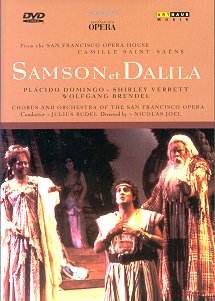DVD Review
Camille SAINT-SAËNS (1835-1921)
SAMSON et DALILA
Opera in Three Acts
Samson…………………………….Placido Domingo
Dalila………………………………Shirley Verret
The High Priest of Dagon………….Wolfgang Brendel
Abimelech………………………….Arnold Voketaitis
 Chorus and orchestra
of the San Francisco Opera
Chorus and orchestra
of the San Francisco Opera
Conducted by Julius Rudel
(recorded in 1981)

 ARTHAUS
MUSIC DVD 100 202 [111 mins]
ARTHAUS
MUSIC DVD 100 202 [111 mins]
Crotchet
AmazonUK AmazonUS
Amazon
recommendations

This sumptuous 1981 production of Saint-Saëns’
single operatic success (his other ventures in the genre disappointed)
catches Domingo in his lusty prime and Verrett, proud and seductive,
as the vengeful Dalila.
Visually, the San Francisco production looks ravishing.
The set designs are bold and striking. Dominating the set of Act I,
is a huge idol of the Philistine’s heathen god, Dagon, standing outside
a massive façade of their temple as Samson urges his despondent
Israelites to throw off their yolk and rebel against Philistine oppression.
(Domingo is in fine sabre-rattling form here pitched against the arrogant
Philistine general, Abimlech [a venomous Voketaitis]). Then there is
the voluptuous boudoir setting for the seduction scene in which Dalila
at last manages to wrest the secret of Samson’s strength from him. Shirley
Verrett manages to invest the famous aria, ‘Softly awakes my heart’
here with not only surface passion but, in her body language, a sense
of duplicity too (although occasionally she is a bit stiff when she
needs to concentrate on her phrasing and projection). The sparse setting
of Act III, Tableau I, is dominated by a huge mill wheel to which a
now-blinded and impotent Samson (his hair having been cut by Dalila)
is shackled. He is full of remorse at having betrayed God’s trust -
and his people. Tableau II of the final act is set in the Temple of
Dagon – another magnificent set with another huge idol and two huge
columns either side of a sacrificial pit. To these columns, a spiteful
Dalila and an evilly triumphant High Priest chain Samson who prays to
God for a miraculous return of his strength so that he might atone for
his weakness in loving the treacherous Dalila. His prayers are answered
and he is able to push aside the columns of the temple bringing down
the building on top of the hedonistic Philistines thus ending the story
and the opera. The destruction of the temple is very well stage-managed
with the columns folding inwards and falling; and massive chunks of
masonry plunging down (shown in back projection) as the panicking crowds
flee as the light dims.
The costume designs are equally stunning and authentic-looking
for the Israelites - based on the numerous pictures some of you will
have become accustomed to from Sunday School bible classes. As far as
the Philistine costumes are concerned, one supposes that the designers
have used some imagination. The High Priest of Dagon (a suitably forbidding
and oily performance from Brendel) has the most OTT gear. In the first
act he has a huge head-piece so that he appears to be peering out of
the head of some huge dragon-like beast. In Act III his costume is dominated
by a huge crest spreading petal-like around the back of his head. The
Philistines’ costumes in the bacchanal of the temple scene are provocative
yet the dancing of the men – especially the lead – in the orgy ballet
is rather limp – well this is San Francisco! However, Rudel ensures
that at least Saint-Saëns seductive music touches ones senses.
The booklet notes that Saint-Saëns originally
intended to write an oratorio around the subject of Samson and Dalila
and "was no doubt inspired by his admiration for Georg Friedrich
Händel and Felix Mendelssohn Barthody." But Saint-Saëns
was finally persuaded by Ferdinand Lemaire, a Creole poet and husband
of one of his cousins, to write an opera. This original intent suggests
why the choral writing is so prominent and strong especially in Act
I. The San Francisco singers acquit themselves well.
A sumptuous production of Saint-Saëns only real
operatic success with Domingo in fine form and a seductive Dalila from
Shirley Verrett.
Ian Lace

